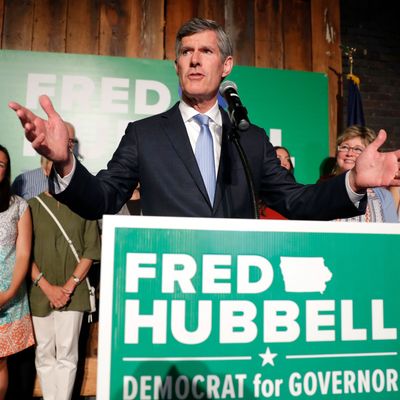
California was the Big Kahuna of June 5 primary states. And New Jersey has four competitive House races going on this year.
But it’s another June 5 primary state, Iowa, that may wind up being the more important bellwether heading into autumn.
Democrats there are targeting two House seats and the governorship, along with other statewide offices and the legislature. But just as importantly, they are challenging the trend of the last two election cycles, in which Iowa tilted red at an alarming pace.
Entering 2012, Iowa was a classic battleground state, with one senator from each party (an arrangement Iowans seemed to like because it protected them against party swings in Washington), a governorship that had gone back and forth since 1998, a legislature with control divided between the two parties, and a three-Democrat, two-Republican House delegation. Thanks to redistricting, a Democratic and Republican House incumbent were forced to face off, and the Republican won. Barack Obama carried the state by just under 6 percent.
In 2014, the “Harkin seat” in the Senate (in which U.S. House Democrat Bruce Braley was the front-runner to succeed the retiring Harkin) went to Republican Joni Ernst by nearly nine points. GOP governor Terry Branstad was reelected by an astonishing 22-point margin. Braley’s First Congressional District, which he had held since 2006 fell to a very conservative Republican, Rod Blum. It was a terrible year for Democrats.
And then it got worse. Of the six states that flipped from Democrat to Republican in the presidential elections of 2012 and 2016, Iowa’s had by far the largest shift in popular votes: from D+6 to R+9 (Ohio was second with a net 11-point shift). From being a classic battleground state for years with most recently a distinct Democratic advantage (Obama carried it by 8.5 points in 2008), Iowa was suddenly more Republican than Texas. (This was particularly astonishing because Iowa was one of the few states Trump lost in the nominating contest.) The GOP also won undivided control of Iowa’s state government for the first time since 1998.
It was reasonably clear at the time that demographics were a big factor in Iowa’s lurch. As I said in 2016 in a piece headlined “Iowa Is So White It’s Turning Red,” Iowa was a microcosm of some important national trends:
Iowa, once a classic blue-leaning battleground state (it went for Obama handily in 2008 and 2012), is moving toward the GOP and particularly Trump because of its high concentration of conservative white working-class voters and its small minority population. To put it another way, Democrats in both presidential and state elections have had to rely in Iowa (as in other Upper Midwestern states) on winning a relatively high percentage of the white vote. The “Obama Coalition” in its full glory just doesn’t exist there. And as Democratic support among white voters — especially evangelicals, and especially non-college-educated people — has gradually eroded, it has gradually made Iowa more hospitable to Republicans, who won a very big midterm victory in the state in 2014.
If Democrats are going to mitigate or reverse their losses among white voters (and especially non-college-educated white voters), states like Iowa are a great place to start. And Iowa Democrats have some good indicators. For one thing, their front-running candidates in three big, competitive races won their primaries easily: wealthy businessman Fred Hubbell in the governor’s race, state legislator Abby Finkenauer in the northeast Iowa First Congressional District, and small-business owner Cindy Axne in the southwest Iowa Third Congressional District. For another, the early signs sure don’t indicate another easy GOP year. A February 2018 Iowa Poll from the very reliable Selzer & Company showed incumbent Governor Kim Reynolds with a narrow 42/37 lead over Hubbell, who isn’t remotely as well known (but who has the resources to make up for that). In May, Roll Call named First District incumbent Representative Rod Blum the country’s most vulnerable House incumbent. Finkenaeuer has been out-raising him, and a late 2017 generic congressional poll of the district showed Democrats with a huge 18-point lead. Third District incumbent David Young isn’t in as much trouble as Blum, but Cook Political Report calls the race competitive (“Leans Republican”). Democrats also think they can make gains in the Iowa House, which is being targeted by the Democratic Legislative Campaign Committee.
Such gains are a matter of sheer conjecture at this point, and the demographic factors that tilted Iowa red in the last two cycles have not gone away. But there’s no better laboratory for how to undermine the Trump coalition. In November, not just the wins and losses, but the exact numbers will be of great interest to analysts on both sides of the partisan barricades.






























